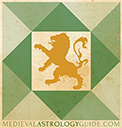Traditional Planetary Domiciles
A really significant difference between modern and medieval astrology is the utilization of the classical system of planetary rulerships (domiciles). The Sun rules Leo, the Moon rules Cancer, but Uranus doesn't rule Aquarius. As mentioned in a previous chapter, the system of astrology was designed around the inclusion of only seven planets. While many modern astrologers characterize the resistance to the inclusion of the outers as clinging to the past, it's more like adopting the attitude of "if it isn't broke, don't fix it."
The image to the right shows the traditional scheme of domicile rulerships. The Sun and Moon each receive one sign as their domicile, while the other five planets each get two; a masculine and feminine sign whereas the Sun and Moon each only receive a sign that matches their gender. The Sun as a primal, masculine force is uncomfortable in feminine signs, while the opposite is true for the Moon.
From here, the signs are divided up into teams belonging to the Sun and Moon and the different relationships that those signs have with Cancer and Leo further fleshes out the philosophy inherent within this system. Digging into this is beyond the scope of this piece. Here is a brief introduction to the Thema Mundi, the Chart of the World.
So, why wouldn't new planets be added into this system and given signs of domicile or rulership? Each planet was given both of its signs for the same reasons (distance from the Earth and relative speed, relationship to the Sun/Moon) and taking one away to give to a different planet causes problems. If Sagittarius and Pisces were both given to Jupiter for the same reason and we just decide that Pisces belongs to Neptune now, why does Jupiter have a sign of domicile at all? Another problem is that planetary domiciles are just one of five forms of essential dignity and having all five levels is crucial to a functional system of astrology. Uranus, Neptune, and Pluto lack those additional levels.
Modern astrologers also tend to come from a different place when it comes to their understanding of planetary domicile. In classical astrology, this is a placement of empowerment for a planet; a planet in domicile is capable of doing something well. In modern astrology, being in rulership is more akin to an affinity or likeness between the sign and planet. As we've seen, affinity isn't really a criteria for domicile assignments, but by misinterpreting the system it's become the only criteria that matters in modern astrology.
Ultimately, it appears that the goal of modern astrologers in assigning sign rulerships to the outer planets is an attempt to get to a one sign per planet system. This system is definitely more egalitarian, but misunderstands the purpose. As we continue to explore our solar system we're slowly coming to the realization that there may not be enough planets for the 12 signs. The controversy over Pluto's planethood aside, it takes it 248 years to complete an orbit through the Zodiac. Is it worth it to continue to look beyond Pluto for new rulers of the signs of Mercury and Venus? This has led some astrologers to focus back inward and assign Ceres, Chiron, or the debunked planet Vulcan to Virgo or the Earth to Taurus.
For these and other reasons, classical astrologers work with the original dignity scheme. It works best for determining planetary ability and specifying planetary significations which is normally what the system is used for. It's also much less open to interpretation than the modern approach. If the outer planets are going to be used in a medieval astrological practice, they need to fit into the system instead of having the rules changed for them.

